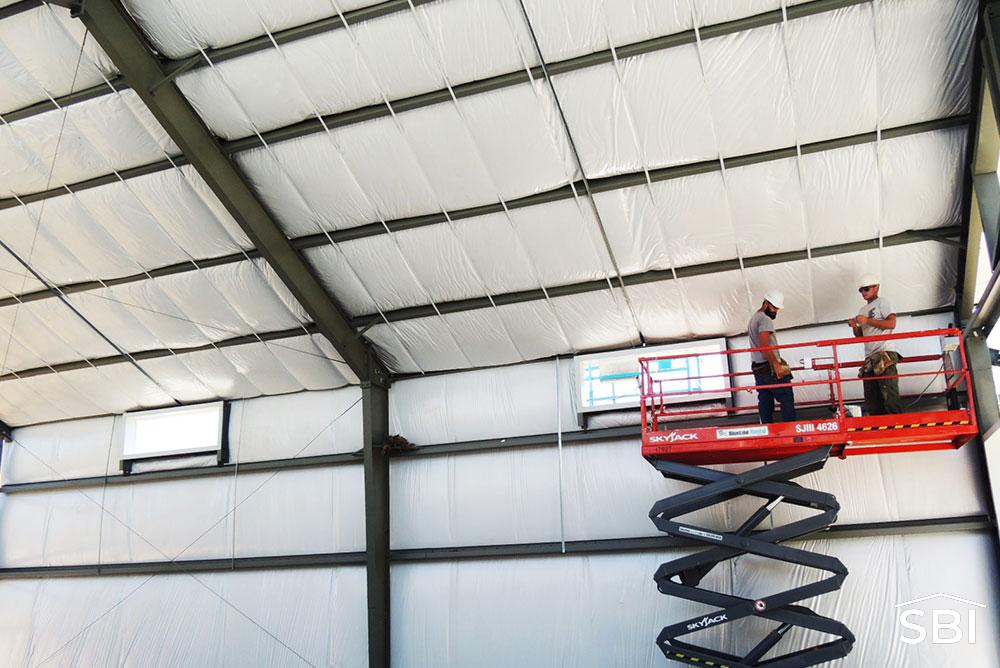Metal Building Insulation Tips

Steel buildings are durable, economical and easy to customize to meet specific needs, but without proper insulation, they can become uncomfortable and inefficient, especially in areas prone to extreme temperatures. Insulating a metal building enhances year-round comfort, and it also lowers heating and cooling bills for the lifetime of the structure. Insulation for metal buildings also leads to a host of other benefits, including enhanced soundproofing and fire resistance.
Before you begin your own insulation project, though, it’s important to consider the best way to insulate a metal building. Here are some tried-and-true tips to help streamline the process and maximize the return on your investment.
Decide What & When to Insulate
Many people who buy steel buildings purchase insulation at the same time. This is often the cheapest way to insulate a metal building. However, you can also add roof or wall insulation to an existing metal building in a retrofit job, allowing you to pick insulation solutions that align with your particular needs and budget.
While when you insulate your steel building matters, you also need to think about whether you want to insulate your building’s roof, walls or both. Insulate both areas to maximize thermal performance. Roof insulation prevents heat loss in the winter and the loss of cool air during the summer, while wall insulation helps the interior of a building maintain consistent temperatures, regardless of the conditions or temperatures outside.
Consider Multi-Layer Insulation Systems
“R-value” refers to the level of thermal resistance a particular insulation blanket offers, and the higher the R-value, the more effective the insulation. While a single-layer insulation system may be adequate if you’re looking to insulate, say, a garage, aircraft hangar or mini storage building, you may want to consider a higher R-value if your building is one where users will live or work.
Double-layer insulation systems allow you to achieve higher R-values than single-layer systems. These systems involve two layers of insulation held up by steel bands and secured to the building’s framing. The added thickness of the two-layer system enhances thermal performance, thereby reducing how hard heating and cooling systems have to work.
To achieve especially high R-values, you may want to consider an Energy Saver insulation system. These two-layer systems feature special energy-saving fabric and are great options for new-construction projects.
Prevent Air Leaks
It’s important that you take steps to prevent air leaks to maximize your metal building insulation’s performance. There are several strategies you might employ to do so, including adding a vapor barrier to your system. A vapor barrier creates a continuous barrier that protects the insulation blankets against moisture and air leaks. Incorporating tape to seal any areas where air might escape can further enhance your insulation system’s overall thermal performance.
Consider Incorporating Thermal Blocks
Adding thermal blocks to an insulation system is another way to potentially save steel building owners thousands of dollars in energy and maintenance costs. Installed between the roof or wall sheeting and the roof purlins or wall girts, these blocks create a structurally sound and watertight system that can substantially enhance insulation performance.
Insulating a metal building is about more than just enhancing comfort – it’s also about making a smart investment in long-term energy efficiency and sustainability. By considering your options and utilizing these tips, you can maximize the performance of your steel building insulation while minimizing energy consumption and operating costs. Whether you’re insulating a new steel building or retrofitting an existing one, installing insulation creates a comfortable, efficient and cost-effective environment you can enjoy for years to come.

